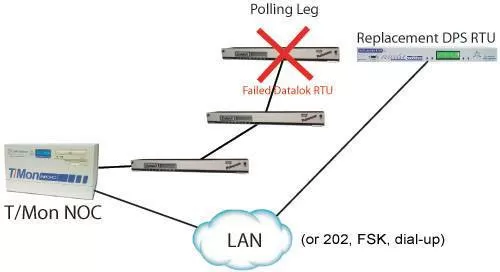Download our free Monitoring Fundamentals Tutorial.
An introduction to Monitoring Fundamentals strictly from the perspective of telecom network alarm management.
1-800-693-0351
Have a specific question? Ask our team of expert engineers and get a specific answer!
Sign up for the next DPS Factory Training!

Whether you're new to our equipment or you've used it for years, DPS factory training is the best way to get more from your monitoring.
Reserve Your Seat TodayAre you still using Datalok remotes and a PDP or other legacy Datalok master? If you are, you've probably noticed a few problems:
A modern monitoring system would solve all of these problems, but you can't simply throw out your legacy equipment and purchase new remotes for all your sites. Almost no one has the budget or engineering resources for that, and its never good to scrap equipment that is still useful.
Fortunately, there is a way to transition to contemporary monitoring technology without throwing away your existing investment in remotes.
The gradual transition plan illustrated below is based upon monitoring microwave equipment, one of the most common applications for Datalok remotes. It can, however, be applied to a variety of other scenarios.
The first phase of the transition is to replace the single point of failure: your PDP or other legacy Datalok master. It's hardly a solid performer in today's monitoring environment, and odds are that you don't have a replacement available. If your master fails, your visibility of your revenue-generating equipment will drop to zero.
"Our DEC PDP-11 master computer crashed on Monday. We contacted the original alarm system manufacturer, only to learn that our master was discontinued and no longer supported... In desperation, we called DPS on Thursday... [A DPS technician] arrived with a DPS T/MonXM master the following Tuesday and we were back in operation the next day."
-Phil Shew, PNM Electric Services
By replacing your Datalok master with a T/Mon NOC or T/Mon SLIM, you're getting a brand-new, fully supported master that supports all the protocols needed to communicate with your existing remotes. You will also gain all the modern features of T/Mon, including:
"T/Mon has been excellent to work with, making interfacing with our current Pulsecom polling units and our 10D dial-up units in the field 100% reliable... Everything was initially setup and working in one day."
-David Wagner, Niagara Mohawk
Because T/Mon is contemporary technology, it will run tremendously faster than your aging Datalok master. You will also have the ability to split up your polling legs into smaller groups that can be polled more frequently and will not disrupt other legs in the event of a failed remote.
And if you don't want T/Mon to be your top-level monitoring device, it can be deployed as an element manager, mediating its alarms (as SNMP traps or another protocol) to your manager of managers (MOM).
DPS can also provide you with a database conversion utility. This utility automatically converts your existing database to T/Mon format, eliminating the need to re-database hundreds or thousands of alarm points that you've accumulated over the years.
Datalok remotes supported by T/Mon:


"Our existing fleet of Datalok 10A's appear basically unaffected by the change to a new master polling device... If anything, they may be a little happier."
-Bryce Pursley, Duke Energy
Your remotes, just like any older equipment, will begin to fail eventually. Odds are that you've already experieced your fair share of Datalok remote failures. Fortunately, with the T/Mon you installed in Phase 1, you have a viable migration path with a master that supports a broad range of remotes, including DPS NetGuardians and KDAs.

With new DPS remotes, you have multiple connectivity options:
It's would be nice to have LAN, overheads, or dedicated circuits available at all of your sites. This would allow you to transition to new remotes on a site-by-site basis. In many cases, however, you aren't so lucky. Fortunately, T/Mon provides you with a very elegant solution.
Because T/Mon segmented your polling legs, you can replace remotes on a leg-by-leg basis instead of replacing your entire system at once. When you decide it's time to replace a leg with modern remotes, you'll simply purchase one new remote for each site on that leg. T/Mon provides a substantial benefit during the transition by uniformly presenting alarms from all of your deployed remotes. Regardless of the alarm source (DPS, Datalok, or other remote), all your alarms will appear in the same format on T/Mon.
The added advantage of this gradual migration path is that working Datalok remotes from migrated legs become your inventory of spares. You will be able to replace failures on other legs with spare remotes for quite some time. Once you finally do run out of spares, you can migrate another leg to new technology and gain a new inventory of spare Datalok remotes.

This approach minimizes waste, maximizes your return on investment, and allows you to migrate to modern technology over several budget cycles.
When you have completed your migration from your Datalok system, you will be simultaneously leveraging the power of T/Mon and reliable DPS remotes. You will experience fewer false alarms thanks to a "stronger" protocol.
Your new monitoring system will have robust capabilities and backing from 7x24 DPS tech support, allowing you to ensure the reliability of your revenue-generating network. Regardless of the alarm source (DPS or Datalok RTU), your alarms will appear in the same format on T/Mon.
"I couldn't be more pleased with the IAM. It works very well with our existing Datalok 10A and 10D remotes, and is much more user-friendly than our old PDP-11 system... DPS and their personnel have truly been a pleasure to work with."
-K. Brueggen, OK Cellular